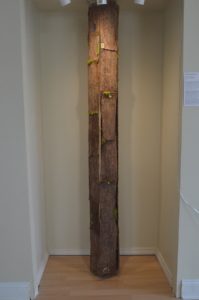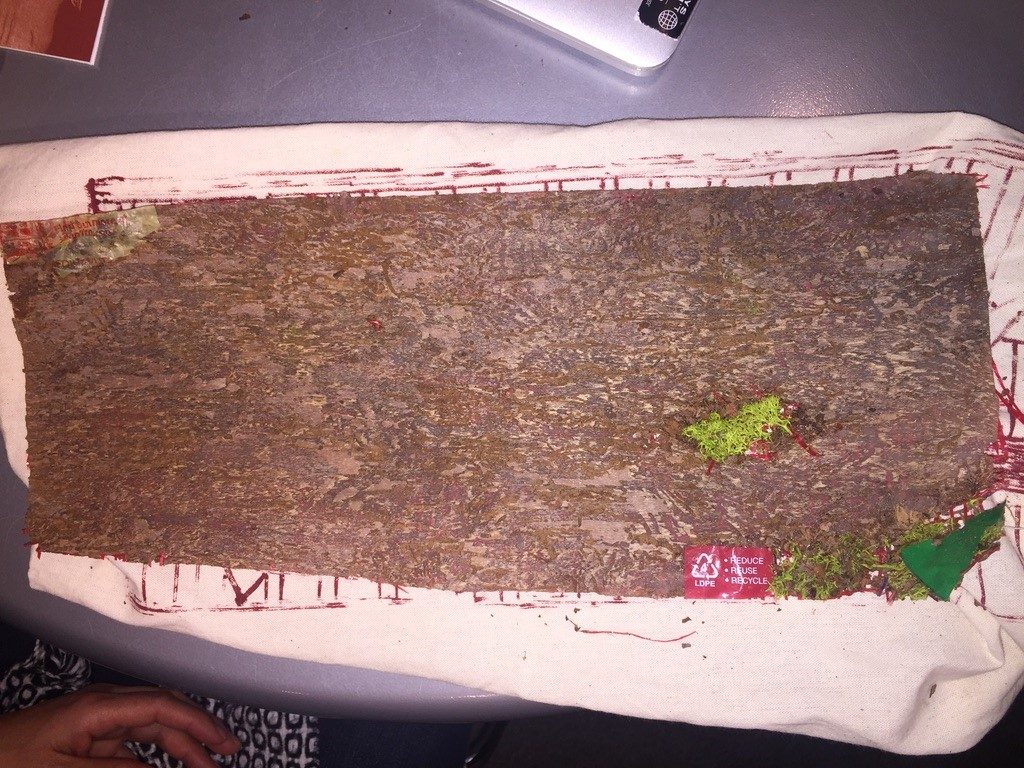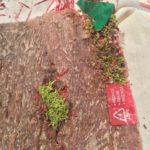“Bonding with Plastic” – an interview with sculpture artist Olga Mercedes Bautista
Interview by TaeHo Lee, LRWP Fall 2018 Raritan Scholar

On Boxing Day 2018, Olga Mercedes Bautisa and I met at the Zimmerli Art Museum in New Brunswick to talk about her art installation that will be featured in Windows of Understanding, a city-wide public art project, on behalf of the Lower Raritan Watershed Partnership. Windows of Understanding is a project of The New Brunswick Community Arts Council, Mason Gross School of the Arts at Rutgers University and the Highland Park Arts Commission that unites local artists, organizations and businesses to promote compassion and awareness around social justice issues in our community. Olga was paired with the Lower Raritan Watershed Partnership, and has developed sculptural pieces that address pollutant and littering concerns at the heart of the LRWP’s community outreach. Her work will be displayed in Kim’s Bike Shop (111 French Street, New Brunswick, NJ) from January 21- February 28, 2019.
Olga was born and raised in Colombia and moved to New Jersey when she was 24. She graduated from Kean University and New Jersey City University with Sculpture and Studio degrees, respectively. Living in Perth Amoby, Olga now travels between the town’s high school where she teaches photography, and her studio. She has also founded and served as director for Perth Amboy’s public art gallery. Check out her website to learn more about her art, and read below to learn about what she found inspiring in her “Windows of Understanding” partnership with the Lower Raritan Watershed Partnership.
TaeHo: What was the environmental ah-ha moment that prompted you to address environmental issues through art?
Olga: Superstorm Sandy. The roof of my studio was damaged. Since then, I noticed that I was looking for something more… real, something that is representing what is going on. For a long time, I had been working with clay, ceramics, mass media, a bunch of installations. I wanted something more real. The roof incident happened six years ago. That personal moment, partially caused by climate change, motivated me to reflect environmental issues to my art.
T: What materials do you use for your art, and what are your processes?
O: Right now I use leaves, tree branches and bark that I found after Sandy, and any trash or litter that gets washed into the Raritan River. After collecting this debris, I used the real bark and make a mold out of it by pouring silicon on top of it. This process allows me to make a copy of the original bark. I then add leaves, trash and other plastic pieces before the silicon dries up to enhance color and texture. When the silicon dries, the material is opaquely visible, and through my assembly I work to highlight interesting words and colors of plastic. These are essentially sheets of a duplicated bark, and I can connect and hang them, shaping them like trees. While on first glance these pieces look like trees, a closer look reveals the bits of plastic and trash.

A sheet of faux bark. Several sheets will be crafted into “hanging trees” and installed in the windows of Kim’s Bike.
T: What is your goal with the sculptural pieces that you are creating?
O: The goal of this piece is to portray the plasticity of the world in our impacts on the environment. I hope that the piece creates conversation between people about their plastic use and make people question their own habits and change their behavior to be more environmentally-friendly. I hope they will see the words and logos of big corporations and brands dissolved into what looks like a real tree made of plastic. Many of these companies are responsible environmental harm. Just like this fake plastic tree, if we do not change our patterns of plastics consumption, plastic will take over everything, no? (laughter). And I want to see how people react to the piece. Let’s just see how they react.
T: How do your pieces reflect the work of the LRWP?
O: Trees are such an important part of the watershed. Appropriating and connecting the benefits of trees to my art, I think, resonates with the work of the LRWP. Trees create oxygen, provide habitats for innumerable kinds of species, and hold the soil and water for the health of the watershed. I see these traits of trees as symbolic in its relation to what the LRWP does to restore the environment.
Additionally, plastic litter and trash is a huge issue for the Raritan River and tributaries. The LRWP regularly conducts clean-ups of the Raritan and area streams, and gathers hundreds of bags of plastic litter a year. The action of collecting and integrating plastic into my work is important. These materials highlight the littering problem in the watershed. As I explained, my approach is to appropriate real tree bark by introducing leaves with plastics debris to mold a new plastic tree bark. I want to show how the plastic which is used to make shopping bags, plastic bottles, or other items found in abundance as litter and debris during clean-ups is impacting the health of area streams and the watershed.
T: Can you tell me more about creating the Resin Piece?
O: The process of creating the plastic tree bark involves handling chemicals for a long time, like three hours per day at least. So, creating the piece takes quite a time, especially when I dry the mold in the barks. And being exposed to these chemicals gives me headaches sometimes. Also, during the winter time, it is difficult to work in studio and collect debris from the waterways because of the cold weather.


T: What effect do you think the Windows of Understanding project has on you and the community?
O: People will be able to communicate something artistic and unique at commercial places as they see and pass through the area with the projects. I hope they will be curious about how the tree piece is done. Taking a look at the piece inside these commercial places is where the curiosity starts. And they will reflect their lives on this piece and create more conversations with their friends or family. This chain effect will, I hope, create a strong connection between people and the environment. I see the Windows of Understanding Project as a great platform to raise local environmental awareness through art.
T: As an artist, what do you stand for?
O: The difficult part of being an artist is communicating a message that is going to transcend the beauty of the piece. For example, some might think seeing a ceramic container is nice and pretty and useable or practical, but how the container makes people think beyond that is difficult. That is what I stand for as an artist. Additionally, not only is the transcendental communication part of art important for me, but especially considering the urgency of the issue these days, addressing environmental crises is extremely important. My project, Bonding with Plastic, addresses the daily stress of individuals facing global crises of overconsumption and climate change. Through my sculptures, I want to contribute to a greater awareness of these issues before we reach a point of no return.
The opening reception for Windows of Understanding is at the Zimmerli Art Museum on January 22nd. Olga’s art installation will be exhibited at Kim’s Bike Shop, 111 French St., starting on January 21st. From 10-noon on January 21 the Olga and the LRWP will participate in walking tours of the art installations and seed plantings at 10am and 2pm.
